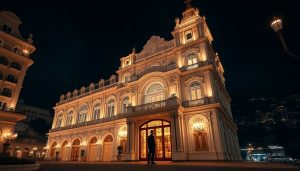Introduction
Walking into a Las Vegas casino in the 1970s was something-even beyond pompous light, high roller, and the danger haze that surrounded them. More so behind the curtain, the mob skims millions and runs the place with an iron fist. Martin Scorsese brought life to that world in “Casino,” which still amazes audiences in its portrayal of greed, violence, and the dark underbelly of the American dream.
“Casino” isn’t just a great movie; it’s based on a true story. It presents real-life figures that controlled Las Vegas. This article tells that true tale behind the movie “Casino” and puts it into perspective with how it appeared on-screen. It also examines the movie’s effects.
Real Life Mobsters Not Just in the Movie
Characters in “Casino” had names of real people. Each played a part in the rise and fall of the mob’s hold in Las Vegas. Let’s check out the real people who inspired the movie.
Frank “Lefty” Rosenthal: The Real Ace Rothstein
Frank “Lefty” Rosenthal was an even better-known name in the world of sports gambling. He was very much involved with numbers. He became a casino executive in Las Vegas. In charge of several casinos, including the Stardust, he was also skimming profits for the Chicago Outfit. That’s what the mob was called.
Rosenthal was very good at what he did. Unfortunately, though, he didn’t have a casino license, so there were some things that went wrong with various authorities. His life is full of mounting stakes and undercurrents of danger. Challenges marked his entire professional journey as a casino executive.
Anthony “Tony the Ant” Spilotro: The Real Soldier Behind Nicky Santoro
Anthony “Tony the Ant” Spilotro was a dangerous guy. He controlled the Las Vegas underground. The reputation Spilotro had was of his brutality. People feared him.
His crimes include murder, extortion, and illegal gambling. It brought unwanted attention toward the Mobs operations. He was a violent man, and it was his own doing that brought him down. His life was ended in a brutal way.
Geri McGee: Woman Who Inspired Ginger McKenna
Geri McGee had many rolls in her life. She was a showgirl. Had affairs with BOTH Rosenthal and Spilotro. But once again- drugs and emotional issues would consume McGee.
Excess and tragedy summed up McGee’s life. She was living fast and furiously in Vegas. She finally died from a drug overdose. McGee’s life is a cautionary tale. The way she’d live showed the dangers of the lifestyle.
From Reality to Celluloid: The Main Differences and Similarities
In Scorsese’s masterful hand, the real story was converted into film format. He did some exacting measure of pen-skip. He was true to many facts. So how close is the movie to reality?
Accuracy vs. Dramatic License
“Casino” is not a documentary. Sure, it gets many details right. But it is more than that. Scorsese has changed a few things, like bombings and murders while keeping much of the character interactions fictionalized.
The whole movie condenses timelines. Compresses events into something. It bent truth and stayed much closer with regard to how it recalled the typhoon feel of that era. It did happen but not really like that.
Character Portrayals: Advantages and Disadvantages
Amazing performances were brought by Robert De Niro, Joe Pesci, and Sharon Stone. They fit into the people they played. De Niro translated the coolness of Rosenthal. Pesci captured the voilent nature of Spilotro. Stone visualized the beauty and vulnerability of McGee.
Nicky Santoro’s portrayal by Pesci is the most memorable. He really turned the ruthless Tony Spilotro inside out. All of them have contributed to making the film realistic. They also poured in a good deal of intensity.
The Imagery Style and Soul of Las Vegas
Scorsese conveyed that atmosphere of Las Vegas in the early seventies. It has brights lights, flashy clothes, and hints of danger. The film showcases the opulence. It also shows the corruption that lurked beneath the surface.
It all brings into an immersive experience of the movie – costumes, set designs and, of course, music. You feel transported there. You’ll taste excitement and danger that time had into store.
This Casino Making: Behind-the-Scenes
Making “Casino” was quite an effort. Scorsese had very specific ideas in mind for the film. The casting was, of course, critical. Yet recreating an era involved several other hurdles.
Scorsese’s Directorial Approach
He is a director known for his signature style. Voiceover narration is the very effective usage of it by him. Bringing voiceover into a thing gives an insight into how they think. Long takes build tension. This is found in “Casino.”
Scorsese would recreate the Las Vegas underworld much as it really existed: through details and the characters’ imperfections, such profoundness an element as well made for him to say how much voiceover he used to keep a lot of the beats of the story very short.
The Casting Process and Performances
Those casting were critical to the overall performance of the film. De Niro, Pesci, and Stone were all perfect fits for their roles. They researched their characters. They did everything they could to embody them fully.
Each actor brought his or her unique talents on the film. Their performances raised the bar for the film, taking it from movie status to timeless classic.
Filming Locations and Set Design
The filmmakers went to great lengths to recreate 1970s Las Vegas. They used real casinos as filming locations. The set design was meticulous. They wanted to make everything authentic.
Conclusions
“Casino” is really a world of greed, violence, and power through which one can glimpse. The movie addresses the dark side of the American dream. It perfectly coincides with real life in a number of ways.



